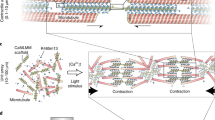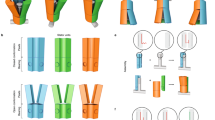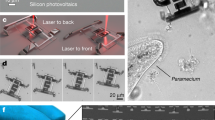Abstract
Nanostructures are of great interest not only for their basic scientific richness, but also because they have the potential to revolutionize critical technologies. The miniaturization of electronic devices over the past century has profoundly affected human communication, computation, manufacturing and transportation systems. True molecular-scale electronic devices are now emerging that set the stage for future integrated nanoelectronics1. Recently, there have been dramatic parallel advances in the miniaturization of mechanical and electromechanical devices2. Commercial microelectromechanical systems now reach the submillimetre to micrometre size scale, and there is intense interest in the creation of next-generation synthetic nanometre-scale electromechanical systems3,4. We report on the construction and successful operation of a fully synthetic nanoscale electromechanical actuator incorporating a rotatable metal plate, with a multi-walled carbon nanotube serving as the key motion-enabling element.
This is a preview of subscription content, access via your institution
Access options
Subscribe to this journal
Receive 51 print issues and online access
$199.00 per year
only $3.90 per issue
Buy this article
- Purchase on SpringerLink
- Instant access to full article PDF
Prices may be subject to local taxes which are calculated during checkout



Similar content being viewed by others
References
Tour, J. M. et al. Recent advances in molecular scale electronics. Ann. NY Acad. Sci. 852, 197–204 (1998)
Judy, J. W. Microelectromechanical system (MEMS): Fabrication, design and applications. Smart Mater. Struct. 10, 1115–1134 (2001)
Craighead, H. G. Nanoelectromechanical systems. Science 290, 1532–1535 (2000)
Roukes, M. L. in Tech. Digest of the 2000 Solid-State Sensor and Actuator Workshop (eds Bousse, L. & Schmidt, M.) 367–376 (Transducer Research Foundation, Cleveland, 2000)
Carr, D. W., Evoy, S., Sekaric, L., Craighead, H. G. & Parpia, J. M. Measurement of mechanical resonance and losses in nanometer scale silicon wires. Appl. Phys. Lett. 75, 920–922 (1999)
Lifshitz, R. & Roukes, M. L. Thermoelastic damping in micro- and nanomechanical systems. Phys. Rev. B 61, 5600–5609 (2000)
Iijima, S. Helical microtubules of graphitic carbon. Nature 354, 56–58 (1991)
Chopra, N. G. et al. Boron nitride nanotubes. Science 269, 966–967 (1995)
Charlier, J.-C. & Michenaud, J.-P. Energetics of multilayered carbon tubules. Phys. Rev. Lett. 70, 1858–1861 (1993)
Kolmogorov, A. N. & Crespi, V. H. Smoothest bearings: Interlayer sliding in multiwalled carbon nanotubes. Phys. Rev. Lett. 85, 4727–4730 (2000)
Ebbesen, T. W. & Ajayan, P. M. Large-scale synthesis of carbon nanotubes. Nature 358, 220–222 (1992)
Tans, S. J. et al. Individual single-wall carbon nanotubes as quantum wires. Nature 386, 474–477 (1997)
Bockrath, M. et al. Single electron transport in ropes of carbon nanotubes. Science 275, 1922–1925 (1997)
Yakobson, B. I., Brabec, C. J. & Bernholc, J. Nanomechanics of carbon tubes: Instabilities beyond linear response. Phys. Rev. Lett. 76, 2511–2514 (1996)
Williams, P. A. et al. Torsional response and stiffening of individual multiwalled carbon nanotubes. Phys. Rev. Lett. 89, 255202 (2002)
Williams, P. A. et al. Fabrication of nanometer-scale mechanical devices incorporating multiwalled carbon nanotubes as torsional springs. Appl. Phys. Lett. 82, 805–807 (2003)
Cumings, J. & Zettl, A. Low-friction nanoscale linear bearing realized from multi-walled carbon nanotubes. Science 289, 602–604 (2000)
Yu, M.-F., Yakobson, B. I. & Ruoff, R. S. Controlled sliding and pullout of nested shells in individual multiwalled carbon nanotubes. J. Phys. Chem. B 104, 8764–8767 (2000)
Cumings, J., Collins, P. G. & Zettl, A. Peeling and sharpening of multiwall nanotubes. Nature 406, 586 (2000)
Collins, P. G., Arnold, M. S. & Avouris, P. Engineering carbon nanotubes and nanotube circuits using electrical breakdown. Science 292, 706–709 (2001)
Poncharal, P., Wang, Z. L., Ugarte, D. & de Heer, W. A. Electrostatic deflections and electromechanical resonances of carbon nanotubes. Science 283, 1513–1516 (1999)
Acknowledgements
We thank N. Bodzin for assistance with graphics. This research was supported in part by the National Science Foundation, and by the Director, Office of Energy Research, Office of Basic Energy Sciences, Materials Sciences Division of the US Department of Energy.
Author information
Authors and Affiliations
Corresponding author
Ethics declarations
Competing interests
The authors declare that they have no competing financial interests.
Supplementary information
41586_2003_BFnature01823_MOESM1_ESM.mpg
Supplementary Movie 1: These first three movie files were captured directly from an SEM. They show three different frequencies of nanoactuator oscillation. (MPG 5521 kb)
41586_2003_BFnature01823_MOESM4_ESM.gif
Supplementary Animation: portrays an animated image of the rotor moving through various positions in a rotation. (GIF 1002 kb)
Rights and permissions
About this article
Cite this article
Fennimore, A., Yuzvinsky, T., Han, WQ. et al. Rotational actuators based on carbon nanotubes. Nature 424, 408–410 (2003). https://doi.org/10.1038/nature01823
Received:
Accepted:
Issue Date:
DOI: https://doi.org/10.1038/nature01823




